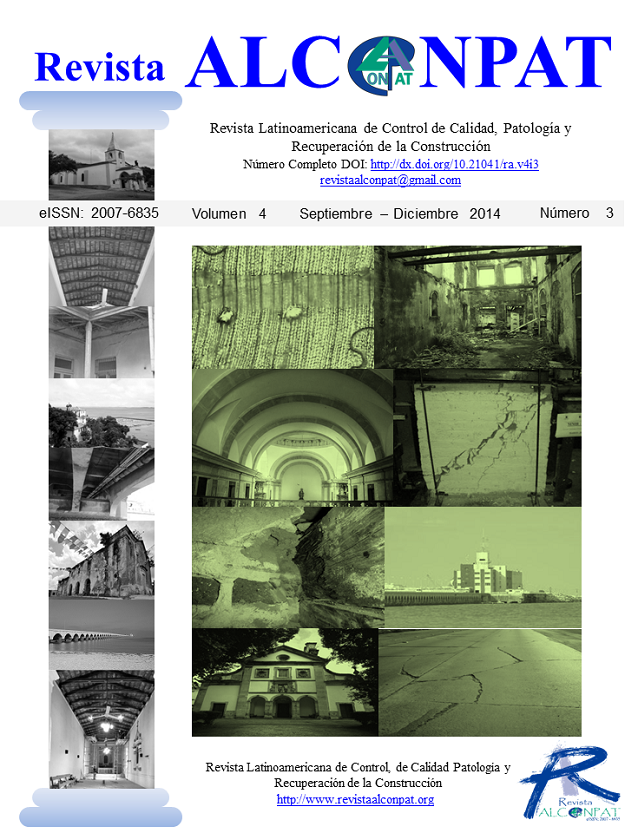Inspección de una losa de 70 años de un edificio en el Golfo de México
DOI:
https://doi.org/10.21041/ra.v4i3.70Keywords:
inspection, repair, chlorides, electrochemical techniquesAbstract
The Progreso pier has a head which is a seventy year-old building that is exposed to an
aggressive environment in the Gulf of Mexico. As a consequence of the chloride exposure
and lack of maintenance, the slabs have shown strong deterioration symptoms. A previous
structural inspection suggested a very expensive and non well understood method to repair
the slab, which made the authorities to think about demolition in spite of the collateral
damage to other elements like columns and beams. Because of the deterioration level, the
authors of this paper suggested a second inspection before demolishing and it was performed
on selected parts of the slab. The objective of this work is to discuss details and results of this
and previous inspection and diagnosis. The new diagnosis indicated the need of demolishing
specific parts of the lower concrete cover of the slab and the substitution of the reinforcement
by CFRP.
Keywords: inspection, repair, chlorides, electrochemical techniques
Downloads
References
ACI 318. Building Code Requirements for Structural Concrete and Commentary, American Concrete Institute.
Andrade C., Alonso, C. (1996) Corrosion rate monitoring in the laboratory and on-site, Construction and Building Materials, Vol. 10, No. 5, pp. 315-328 DOI: https://doi.org/10.1016/0950-0618(95)00044-5
ASTM C876. Test Method for Half-Cell Potentials of Reinforcing Steel in Concrete
ASTM C-1152. Standard Test Methods for Water-Soluble Chloride in Mortar and Concrete
Castro P, Troconis O., Moreno E., Torres-Acosta A., Martínez-Madrid M y Knudsen A. (2002), Performance of a 60-year-old concrete pier made with stainless steel reinforcement in Mexico. Materials Performance Vol. 4, No. 10, pp. 50-55
Castro P.: The chloride threshold for corrosion onset of reinforced concrete in two tropical marine micro-climates of Yucatán-México. In: N. Banthia, K. Sakai, and O.E. Gjørv (eds), Third International Conference on Concrete under Severe Conditions. Environment and Loading, The University of British Columbia, Vancouver, Canada Vol. 1 (2001), 151-158.
Christensen A., (1954) Pier at Progreso, 50 Years of Civil Engineering, Christiani & Nielsen, Copenhagen, Denmark,.
Fagerlund, G. (1986) On the Capillarity of Concrete, Nordic Concrete Research, No. 1, Oslo, paper No. 6.
NMX-C-169-ONNCCE-2009. Industria de la Construcción-Concreto-Extracción de Especímenes Cilíndricos o Prismáticos de Concreto Hidráulico Endurecido.
Millard S. G. (1993), Corrosion rate measurements of in situ reinforced concrete structures”. in: Proceedings of the Institute of Civil Engineer, Structures and Building., Vol. 99, pp. 84-88. DOI: https://doi.org/10.1680/istbu.1993.22556
Troconis O. y Miembros de la Red DURAR (1997), Manual de Inspección, Evaluación y Diagnóstico en Estructuras de Hormigón Armado, CYTED, Programa XV.b, Durabilidad del Refuerzo, 207 p.
Downloads
Published
How to Cite
Issue
Section
License
_______________________________
License in effect from September 2020
You are free to:
- Share — copy and redistribute the material in any medium or format for any purpose, even commercially.
- Adapt — remix, transform, and build upon the material for any purpose, even commercially.
- The licensor cannot revoke these freedoms as long as you follow the license terms.
Under the following terms:
- Attribution — You must give appropriate credit , provide a link to the license, and indicate if changes were made . You may do so in any reasonable manner, but not in any way that suggests the licensor endorses you or your use.
- No additional restrictions — You may not apply legal terms or technological measures that legally restrict others from doing anything the license permits.
Notices:
You do not have to comply with the license for elements of the material in the public domain or where your use is permitted by an applicable exception or limitation .
No warranties are given. The license may not give you all of the permissions necessary for your intended use. For example, other rights such as publicity, privacy, or moral rights may limit how you use the material.





















.png)














